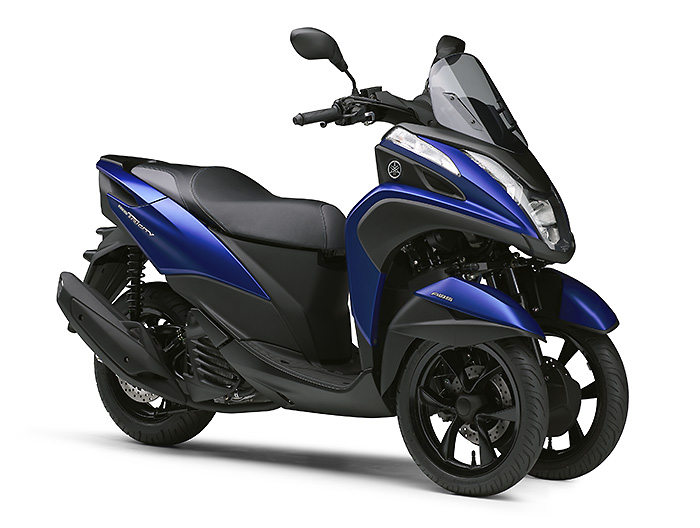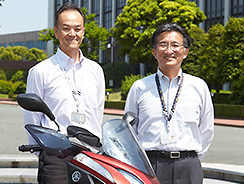The Near Future Created by LMW Vehicles
Introducing the stories behind Yamaha Motor's technologies.
The release of the Tricity 125 in 2014 gave many people their first encounter with Yamaha’s LMW* technology. Then, at the Tokyo Motor Show the following year, Yamaha displayed the MWT-9 prototype (#1) as a reference vehicle to show a new form of sport mobility employing this technology. It was conceived under a “Cornering Master” concept to redefine what cornering can mean in the realm of sporty riding. And then in September 2016, Yamaha released the new Tricity 155 model (#2) featuring a 155cc “BLUE CORE” engine for achieving real riding fun and good fuel efficiency, a newly developed frame and more. Launched in Europe before subsequent releases in other countries, the Tricity 155 can be ridden on expressways and thus expands the route and use options available for riders.
*LMW (Leaning Multi Wheel): Yamaha’s name for vehicles with three or more wheels that can lean through turns like a motorcycle (Japan Patent Office Trademark #5646157).
| The History of Yamaha LMW Technology | |
|---|---|
| 1976 | Various patent applications made for vehicles using two front wheels |
| 2007 | Tesseract four-wheeled concept vehicle displayed at the Tokyo Motor Show |
| 2008 | R&D continues on the OR2T prototype to practicalize the Tesseract concept |
| R&D on LMW technology suspended due to the 2008 global financial crisis | |
| 2010 | Limited-term project initiated to examine possibilities for next-generation mobility |
| Decision made to commercialize a vehicle with two front wheels using LMW technology | |
| 2011 | Full-fledged launch of a project to develop an LMW production model |
| 2014 | Sales of the Tricity 125 begin in Thailand in April and Japan in September |
| 2015 | MWT-9 prototype exhibited as a reference vehicle at the Tokyo Motor Show |
| ABS version of the Tricity 125 released on the Japanese market | |
| 2016 | Tricity 155 released in September as global model with sales beginning in Europe |


LMW Developer Interview: From Industrial Robots to LMW Vehicles
Interviewees (#3)
Takashi Kaieda
General Manager of LMW Development Division, PF Model Development Section, PF Model Unit, Yamaha Motor Co., Ltd.
Kazuhisa Takano
Group Leader of LMW Development Division, PF Model Development Section, PF Model Unit, Yamaha Motor Co., Ltd.
Takashi Kaieda was in charge of consolidating business strategy and served as the division’s general manager from the very beginning of Yamaha’s production LMW development. Looking back on the state of things when production model development began in 2011: “Because I had worked on developing industrial robots for more than 20 years after I first joined Yamaha, when I was put in charge of the LMW project it was honestly like changing jobs,” says Kaieda. “So it was basically starting out from scratch; I wasn’t able to use most of the know-how and connections I had acquired until then.”
From Building MotoGP Racebikes to Developing a Production Model for the First Time
“My dream of building the world’s fastest motorcycle was realized when I was put in charge of developing the chassis for our MotoGP factory racebike,” says Kazuhisa Takano. “After that I thought it might be time to move on to a new career step and it was just at that time that I got this offer.”
As the Project Leader for the Tricity 125, Takano would have to build Yamaha’s first bike with two front wheels, but on top of that he was developing a production model for the first time as well. To help bring the project together, Group Leader Yutaka Kubo was brought onboard to help with his wealth of experience in production motorcycle development. But still, the initial full-time team had only three members, so the LMW project began with just a small group of employees that had walked diverse career paths until then. But the man who chose these core members, Kunihiko Miwa, knew from having also worked in the racing department that Takano was a creative man full of ideas and had exceptional skill when it came to developing structures and mechanisms.
“Since we were starting from scratch, a lot of what we did the first year was repeated trial-and-error at quite a high pace,” recalls Takano. “Even though I’d worked for so long on bikes for the world’s premier motorcycle racing class, there may not have been any time when I was trying so many things in such a short span of time as this.” But, having seen Takano at work, Kaieda notes: “Takano always has clear images in mind of what he’s after. There’s basically no doubt or uncertainty with him, so although he may call it trial-and-error, development actually progressed quite smoothly.”
“With racebikes, the opportunities for test-riding are limited and you won’t be competitive if you can’t bring the finished machine to the track with it already at a high level of performance,” Takano remarks. “When judged in that context, you could say that the Tricity 125’s development did move forward well. Regarding the specifications of the cantilevered telescopic suspensions and parallelogram link combination, it sufficiently met the targets I had set for us to meet, so I was confident the end product would ride quite well.”
“The most important thing for a vehicle is that it reacts as expected and has a feeling of stability.”
In fact, from the early stages of development the Tricity 125 prototype had already cleared initial performance goals and rode with a good feeling of stability.
“Contrary to what one might think, the most important thing for a racebike is that it rides with consistent stability,” declares Takano. “Only when the machine runs with a consistently high level of stability can we then begin to pursue outstanding engine performance. The most important thing is a ride that doesn’t betray the rider’s expectations. We designed the Tricity 125 aiming to offer the means to experience leaning through turns—something innately fun with motorcycles—to more people than ever before. But behind its performance lies the experience I gained from developing race machines, the exact opposite kind of motorcycle to a commuter model.”
LMW vehicles and their innovative mechanisms are Yamaha’s latest creation, and they are imbued with Takano’s unshakable devotion to motorcycles and the fun they bring.
“I believe LMW vehicles have limitless potential.”
However, Yamaha has only taken its first steps with LMW technology. Kaieda shares his dreams for the future ahead: “The Tricity Series we launched in 2014 is still only a line of standard commuter vehicles, and we will continue to refine and improve it so that even people who had given up on the idea of ever riding a motorcycle can ride this vehicle without hesitation.
“However, the real challenge to establish LMW technology has only just begun. We were delighted to see the very enthusiastic response to the MWT-9 reference vehicle we displayed at the 2015 Tokyo Motor Show, and besides that kind of sport model, we already have a variety of other ideas for employing LMW technology. I want to see us give form to each and every one of the dreams we have for the platform, so we can expand the field of vehicles that can lean through turns and get more and more people to discover the fun riding can bring.”
Clearly, Yamaha’s LMW developers are working every day excited by the seemingly infinite potential of LMW vehicles.
To Someday Create Motorcycles That Lean, But Do Not Fall
The ultimate goal that LMW technology aims for is to someday build a bike that does not fall. Since a motorcycle is a vehicle that gives the rider an exhilarating feeling by leaning through turns, it will not be an easy task to actually build such a vehicle.
But, in order to approach that ultimate goal, we believe the important thing is to see how much we can get the machine to assist the rider across constantly changing road conditions and covering the different levels of rider skill and technique.
All this connects to Yamaha’s exclusive development ideal of Jin-Ki Kanno, which is the seductive exhilaration felt when one with the machine that we quantify and integrate into a machine’s performance. Our LMW technology is a new challenge and one more path of progress we have set for the future.


